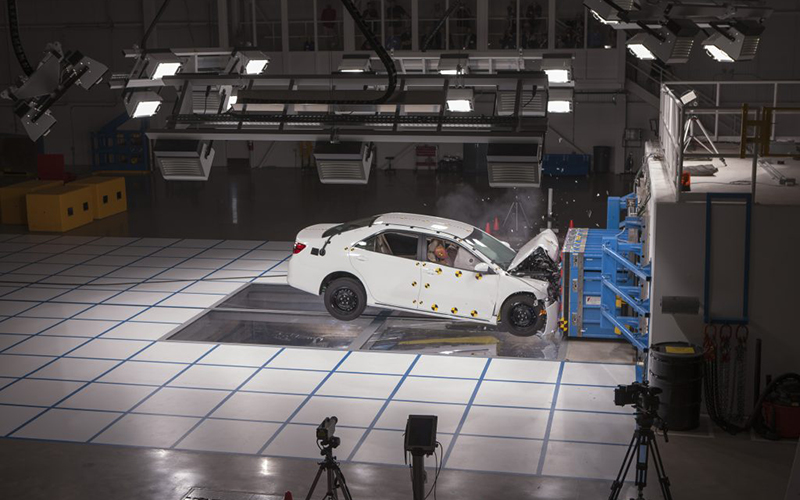
Toyota’s Collaborative Safety Research Center (CSRC) in Ann Arbor introduced nine projects as part of the next phase of its automotive safety research, backed by a five-year, $30 million commitment announced last year.
The new research projects will examine the diversity of safety needs and analyze safe mobility options that accommodate a variety of applications, physical characteristics, and levels of accessibility for people and society.
“The foundation of CSRC is built on collaborations to tap outstanding safety researchers and institutions throughout the country, and we’re excited to continue these strategic partnerships into the future,” says Danil Prokhorov, director of Toyota’s CSRC and Future Research Department (FRD).
“As we explore inclusive safety technologies for meeting unique and ever-evolving needs in our pursuit of mobility for all, we’ll also continue to publish our CSRC research discoveries for others to help foster societal benefit.”
The nine projects are:
“Tailored Training Based on Driver’s Self-perceptions and Knowledge” will be conducted the University of Massachusetts-Amherst. It will examine how to promote proper use of safety technology when faced with preexisting misconceptions. Researchers will use a combination of longitudinal observation and driving simulator research to investigate various approaches of educating misinformed users about safety technologies.
“Risk-anticipation Training to Enhance Novice Driving” will be conducted also be conducted by the University of Massachusetts-Amherst. It will examine how an interactive tool could help novice drivers to better identify hazards in common driving scenes. Researchers will study software designed to improve scanning, target identification, and correct glances and its effect on driving performance, future crashes, and traffic violations.
“Caregivers’ Attitudes Towards Pediatric Vehicular Heatstroke Risks and Solutions” will be conducted by the Children’s Hospital of Philadelphia. It will try to answer the question of what motivates caregivers to take preventive steps against child heatstroke in vehicles. Researchers will use scientific surveys and focused group interviews to analyze societal attitudes surrounding perceived risk factors and acceptance of mitigation strategies.
“Library of Real-world and Simulated Corner Cases for AVs-Vulnerable Road User (VRU) Crashes and Interactions,” will be conducted by the University of Michigan-Dearborn and the U-M Transportation Research Institute (UMTRI). It will examine how to coordinate shared experiences among automated driving developers and stakeholders regarding VRU safety. Researchers will study multiple naturalistic driving databases to identify complex, unique VRU interaction scenarios for use in safety assessment.
“Evolving Characteristics of Non-Driving Activities” will be conducted by the Massachusetts Institute of Technology. It will look at what non-driving related activities drivers engage in while using Level 2 driving assistance features with different types of driver monitoring. Researchers will study driver behavior in vehicles equipped with Level 2 driving assistance features that have driver monitoring systems.
“Quick Response Consumer Education Needs and Over-the-Air Updates” will be conducted by the University of Iowa. It will attempt to answer the question of how users should be educated about changes to safety technology operation because of an over-the-air update. Researchers will study how various changes to safety technology operation impacts driving performance and behavior, and then investigate various education methods to maximize understanding of new operation.
“Driver Evasive Action Trends in Intersection Crashes” will be conducted by Virginia Tech and the Virginia Tech Transportation Institute. It will examine how driver assistance technology helps drivers to naturally avoid intersection crashes. Researchers will analyze several naturalistic intersection driving datasets with crash/near-miss/normal intersection driving scenarios to develop and integrate driver models for a driver supportive intersection system.
“Predicting Behavior of Vulnerable Road Users (Bicycle and e-Scooter)” will be conducted by Indiana University-Purdue University Indianapolis. It will look at how interactions between bicyclists, micro mobility users, and other traffic participants be enhanced to improve safety. Researchers will collect and analyze naturalistic driving data in multiple U.S. cities to create interaction models between vehicles, bicyclists, and e-scooters to develop a stress-free driver assistance.
“Equity in Crash Protection: Considering Human Variation for Assessing Injury” will be conducted by the UMTRI. It will examine what parameters affect injury differences, particularly to chest, between different groups. Researchers will use the THUMS human body model to investigate different body shapes of both males and females and how to enhance crash protection for population diversity.
Projects are selected based on their application to CSRC’s new research tracks for the next five-year period — human-centric, safety assurance, and assessment — which weaves together the diverse interdisciplinary backgrounds of CSRC’s team. Each project is designed to be completed in a short amount of time to emphasize agility for more rapid results.
CSRC is considering additional projects and will announce them at a later date. CSRC will also seek out partnerships that can offer new perspectives and different research methods for addressing safety issues facing at-risk and vulnerable populations.
Toyota created the CSRC in 2011 to advance traffic safety for the industry and society through open partnerships with universities, hospitals, and other institutions. It has since received $85 million for foundational safety research, including the factors that lead to distracted driving and the development of tools and testing procedures related to the efficacy of advanced driver assistance systems (ADAS).
To learn more about the five-year, $30 million commitment that is funding these projects, click here.











